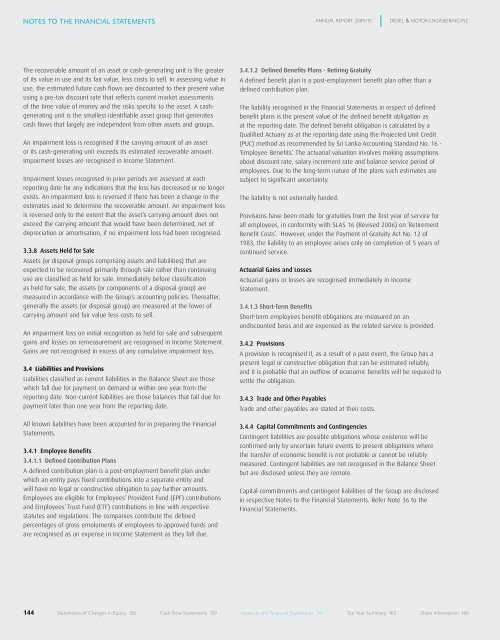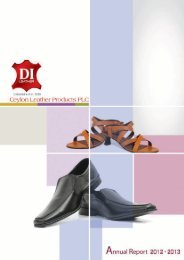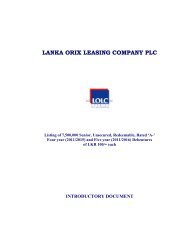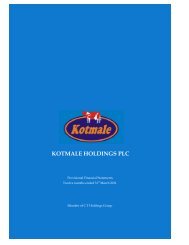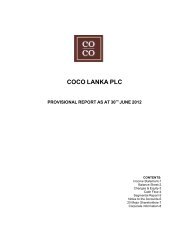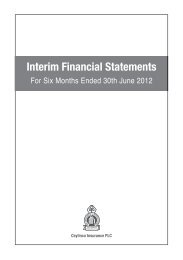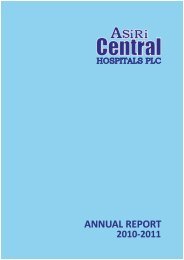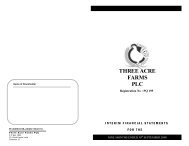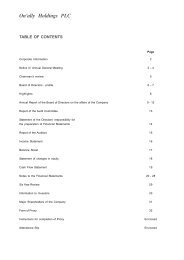directors - Colombo Stock Exchange
directors - Colombo Stock Exchange
directors - Colombo Stock Exchange
Create successful ePaper yourself
Turn your PDF publications into a flip-book with our unique Google optimized e-Paper software.
notes to the Financial statements<br />
The recoverable amount of an asset or cash-generating unit is the greater<br />
of its value in use and its fair value, less costs to sell. In assessing value in<br />
use, the estimated future cash flows are discounted to their present value<br />
using a pre-tax discount rate that reflects current market assessments<br />
of the time value of money and the risks specific to the asset. A cashgenerating<br />
unit is the smallest identifiable asset group that generates<br />
cash flows that largely are independent from other assets and groups.<br />
An impairment loss is recognised if the carrying amount of an asset<br />
or its cash-generating unit exceeds its estimated recoverable amount.<br />
Impairment losses are recognised in Income Statement.<br />
Impairment losses recognised in prior periods are assessed at each<br />
reporting date for any indications that the loss has decreased or no longer<br />
exists. An impairment loss is reversed if there has been a change in the<br />
estimates used to determine the recoverable amount. An impairment loss<br />
is reversed only to the extent that the asset’s carrying amount does not<br />
exceed the carrying amount that would have been determined, net of<br />
depreciation or amortisation, if no impairment loss had been recognised.<br />
3.3.8 Assets Held for Sale<br />
Assets (or disposal groups comprising assets and liabilities) that are<br />
expected to be recovered primarily through sale rather than continuing<br />
use are classified as held for sale. Immediately before classification<br />
as held for sale, the assets (or components of a disposal group) are<br />
measured in accordance with the Group’s accounting policies. Thereafter,<br />
generally the assets (or disposal group) are measured at the lower of<br />
carrying amount and fair value less costs to sell.<br />
An impairment loss on initial recognition as held for sale and subsequent<br />
gains and losses on remeasurement are recognised in Income Statement.<br />
Gains are not recognised in excess of any cumulative impairment loss.<br />
3.4 Liabilities and Provisions<br />
Liabilities classified as current liabilities in the Balance Sheet are those<br />
which fall due for payment on demand or within one year from the<br />
reporting date. Non-current liabilities are those balances that fall due for<br />
payment later than one year from the reporting date.<br />
All known liabilities have been accounted for in preparing the Financial<br />
Statements.<br />
3.4.1 Employee Benefits<br />
3.4.1.1 Defined Contribution Plans<br />
A defined contribution plan is a post-employment benefit plan under<br />
which an entity pays fixed contributions into a separate entity and<br />
will have no legal or constructive obligation to pay further amounts.<br />
Employees are eligible for Employees’ Provident Fund (EPF) contributions<br />
and Employees’ Trust Fund (ETF) contributions in line with respective<br />
statutes and regulations. The companies contribute the defined<br />
percentages of gross emoluments of employees to approved funds and<br />
are recognised as an expense in Income Statement as they fall due.<br />
144<br />
ANNUAL RepoRt 2009/10 DIeseL & MotoR eNGINeeRING pLC<br />
3.4.1.2 Defined Benefits Plans - Retiring Gratuity<br />
A defined benefit plan is a post-employment benefit plan other than a<br />
defined contribution plan.<br />
The liability recognised in the Financial Statements in respect of defined<br />
benefit plans is the present value of the defined benefit obligation as<br />
at the reporting date. The defined benefit obligation is calculated by a<br />
Qualified Actuary as at the reporting date using the Projected Unit Credit<br />
(PUC) method as recommended by Sri Lanka Accounting Standard No. 16 -<br />
‘Employee Benefits’. The actuarial valuation involves making assumptions<br />
about discount rate, salary increment rate and balance service period of<br />
employees. Due to the long-term nature of the plans such estimates are<br />
subject to significant uncertainty.<br />
The liability is not externally funded.<br />
Provisions have been made for gratuities from the first year of service for<br />
all employees, in conformity with SLAS 16 (Revised 2006) on ‘Retirement<br />
Benefit Costs’. However, under the Payment of Gratuity Act No. 12 of<br />
1983, the liability to an employee arises only on completion of 5 years of<br />
continued service.<br />
Actuarial Gains and Losses<br />
Actuarial gains or losses are recognised immediately in Income<br />
Statement.<br />
3.4.1.3 Short-Term Benefits<br />
Short-term employees benefit obligations are measured on an<br />
undiscounted basis and are expensed as the related service is provided.<br />
3.4.2 Provisions<br />
A provision is recognised if, as a result of a past event, the Group has a<br />
present legal or constructive obligation that can be estimated reliably,<br />
and it is probable that an outflow of economic benefits will be required to<br />
settle the obligation.<br />
3.4.3 Trade and Other Payables<br />
Trade and other payables are stated at their costs.<br />
3.4.4 Capital Commitments and Contingencies<br />
Contingent liabilities are possible obligations whose existence will be<br />
confirmed only by uncertain future events to present obligations where<br />
the transfer of economic benefit is not probable or cannot be reliably<br />
measured. Contingent liabilities are not recognised in the Balance Sheet<br />
but are disclosed unless they are remote.<br />
Capital commitments and contingent liabilities of the Group are disclosed<br />
in respective Notes to the Financial Statements. Refer Note 36 to the<br />
Financial Statements.<br />
statements of Changes in equity 138 Cash flow statements 139 Notes to the financial statements 141 ten year summary 165 share Information 166


